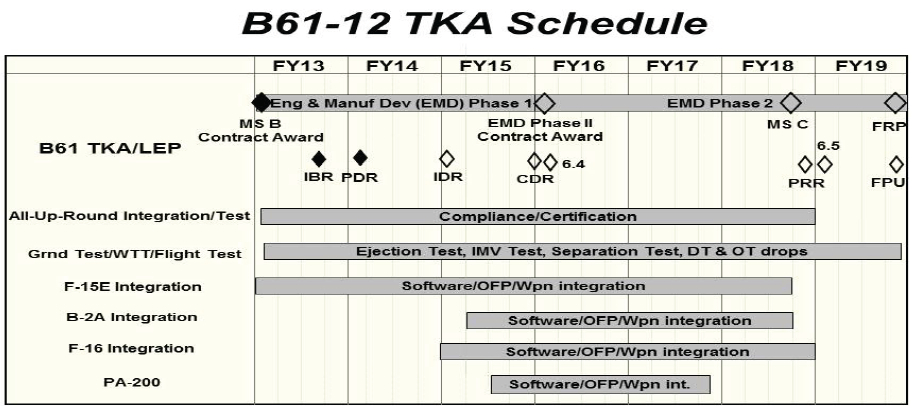B61-12 Nuclear Bomb Integration On NATO Aircraft To Start In 2015

Integration of the new guided B61-12 nuclear bomb will begin in 2015 on NATO Tornado and F-16 aircraft, seen here in 2008 at the Italian nuclear base at Ghedi Torre for the Steadfast Noon nuclear strike exercise. Image: EUCOM.
By Hans M. Kristensen
The US Air Force budget request for Fiscal Year 2015 shows that integration of the B61-12 on NATO F-16 and Tornado aircraft will start in 2015 for completion in 2017 and 2018.
The integration marks the beginning of a significant enhancement of the military capability of NATO’s nuclear posture in Europe and comes only three years after NATO in 2012 said its current nuclear posture meets its security requirements and that it was working to create the conditions for a world without nuclear weapons.
The integration will take place on Belgian, Dutch, and Turkish F-16A/B and on German and Italian PA-200 Tornado fighter-bombers. It is unknown if US and NATO F-16s happen simultaneously or US aircraft are first, but the process will last four years between 2015 and 2018. Integration of German and Italian Tornados will take a little over two years (see graph below).

The USAF budget request shows the timelines for integration of the B61-12 onto US and NATO legacy aircraft. Later the weapon will also be integrated onto the F-35A and LRS-B next-generation long-range bomber.
The B61-12 will also be integrated on USAF F-15E (integration began last year), F-16C/D, and B-2A aircraft, and later on the F-35A Lightning II. The F-35A will later replace the F-16s. The US Air Force plans to equip all F-35s in Europe with nuclear capability by 2024.
In addition to the US Air Force, the nuclear-capable F-35A will be supplied to the Dutch, Italian, Turkish, and possibly Belgian air forces.
From the mid-2020s, the B61-12 will also be integrated on the next-generation heavy bomber (LRS-B) planned by the US Air Force.
The integration work includes software upgrades on the legacy aircraft, operational flight tests, and full weapon integration. Development of the guided tail kit is well underway in reparations for operational tests. Seven flight tests are planned for 2015. The nuclear warhead and some non-nuclear components won’t be ready until the end of the decade. The first complete B61-12 is scheduled for 2020.
Through 2019, the integration efforts are scheduled to cost more than $1 billion. Another $154 million is needed to improve security at the nuclear bases in Europe.
Integration of US nuclear weapons onto aircraft of non-nuclear weapon states that have signed the nuclear Non-Proliferation Treaty and promised “not to receive the transfer from any transferor whatsoever of nuclear weapons or other nuclear explosive devices or of control over such weapons or explosive devices directly, or indirectly,” is, to say the least, problematic.
The arrangement of equipping non-nuclear NATO allies with the capability and role to deliver US nuclear weapons was in place before the NPT entered into effect and was accepted by the NPT regime during the Cold War. But for NATO to continue this arrangement contradicts the non-proliferation standards that the member countries are trying to promote in the post-Cold War world.
How scattering enhanced nuclear bombs across Europe in five non-nuclear countries will enable “bold reductions” in US and Russian non-strategic nuclear weapons in Europe and help create the conditions for a world without nuclear weapons is another question.
This publication was made possible by a grant from the Ploughshares Fund. The statements made and views expressed are solely the responsibility of the author.
Satellite imagery has long served as a tool for observing on-the-ground activity worldwide, and offers especially valuable insights into the operation, development, and physical features related to nuclear technology.
This report outlines a framework relying on “Cooperative Technical Means” for effective arms control verification based on remote sensing, avoiding on-site inspections but maintaining a level of transparency that allows for immediate detection of changes in nuclear posture or a significant build-up above agreed limits.
The grant comes from the Carnegie Corporation of New York (CCNY) to investigate, alongside The British American Security Information Council (BASIC), the associated impact on nuclear stability.
Satellite imagery of RAF Lakenheath reveals new construction of a security perimeter around ten protective aircraft shelters in the designated nuclear area, the latest measure in a series of upgrades as the base prepares for the ability to store U.S. nuclear weapons.